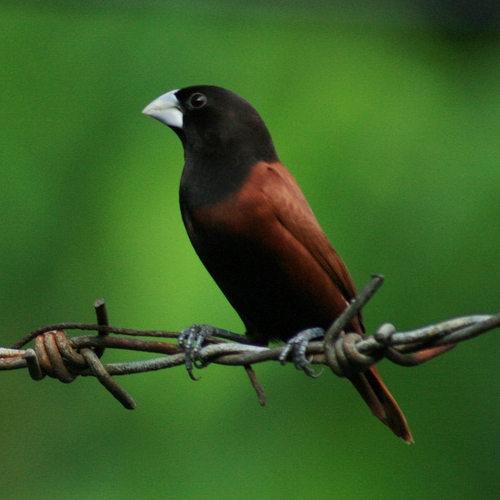
While working for a bird importer in years past, I had the opportunity to hand-raise a number of finch chicks. The following information is based on recent and past experiences with the Black-Headed Mannikin (Lonchura atricapilla), also known as the Black-Headed Nun or Munia, but could be applied to a number of related birds.
The youngest chicks I’ve worked with were 4-6 days old and, like most Mannikins, had hatched in a domed nest (please see photo). They were reared in plastic containers lined with dry grass in an incubator set at 90 F (range: 86-93 F).
Feeding Nestlings
I feed very young finches at 2 hour intervals, from 5 or 6 AM to midnight at first, and cut back over 2 weeks or so to 6 AM – 8 PM. Hand Rearing Formula (warmed per directions) offered via syringe serves well as a base diet. Although not strictly necessary, to this I add a “drop” of peanut butter and 2 drops per syringe of sunflower oil. A bit of cooked egg yolk and a drop of Avitron, provided three times weekly, completes the feeding regime.
Despite their delicate appearance, healthy Mannikin chicks are ravenous. After a few days, they develop the amusing habit of raising one wing in order to ward off competitors…mini “jousting matches” sometimes break out!
Young Mannikins can only take a small amount at each feeding, and will choke or aspirate food into the lungs if it is forcibly squirted down their throats. The safest way to feed them is to gently release from the syringe just enough food to fill their mouths…at a frequency of every 2 hours, this will provide quite enough nourishment.
Care of Fledglings
 Upon fledging, the chicks should be fed on a 6AM – 8PM schedule until they begin pecking at food on their own. Most begin trying solid food on the fifth day after fledging, but this varies widely…close observation is very important at this point.
Upon fledging, the chicks should be fed on a 6AM – 8PM schedule until they begin pecking at food on their own. Most begin trying solid food on the fifth day after fledging, but this varies widely…close observation is very important at this point.
Their first meals should be offered on the cage floor, not in cups, to assure that they are aware of its presence. Seed-based Finch Nestling Food, Egg Food and cut sprouts should be available at all times.
Once the fledglings have begun to feed regularly on their own, you can gradually reduce the syringe feedings to 2-3 times per day. Continue this schedule until they lose interest in the syringe, which may take an additional 2-3 weeks. It is a mistake to rush the weaning process – birds decline in condition very rapidly at this age, and poor nutrition during the fledgling period will have lifelong consequences for their health.
Black-Headed Mannikins and related birds prefer to sleep in a nest or enclosed space, even outside of the breeding season. Fledglings raised together usually crowd into one covered nest, but provide extras in case of aggression.
Although generally quite hardy as adults, Mannikins are cold-sensitive as chicks. Until you are certain that their immune systems are functioning well, take extra care to keep the youngsters warm at night (a hot spot of 86-90 F, with an ambient temperature of 80-82 F, works well). A red or black night bulb, designed for use with reptiles, will provide heat without disturbing their day/night cycle.
Further Reading
Please see my article Introducing Mannikins for more information on these beautiful finches.
A video of Black-Headed Mannikins in the wild is posted here.
Black headed Finch image referenced from wikipedia and originally posted by SnowmanradioFinch nest image referenced from wikipedia and originally posted by Kguirnela
 That Bird Blog – Bird Care and History for Pet Birds
That Bird Blog – Bird Care and History for Pet Birds
